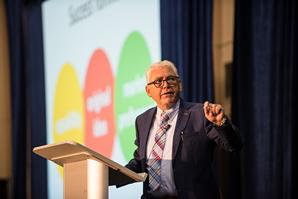By Bill Bregar
SENIOR STAFF REPORTER
Published: September 25, 2014 10:53 am ET
Updated: September 25, 2014 10:58 am ET

Image By: SPE Thermoforming Division
Former Lego A/S executive Christian Majgaard at the SPE Thermoforming conference.
SCHAUMBURG, ILL. — A company can get stuck when they get big and successful — executives can fall in love with their mission statements, Christian Majgaard, a former longtime executive of Danish toymaker Lego A/S told thermoforming industry leaders.
He pointed to what he called “away-day meetings,” projecting on a screen a photograph of a generic hotel conference room.
“So they rent a room at a Holiday Inn Express somewhere. And then they sit there and do the most crazy work you can think of, and then they so some poetry. And maybe even have a writer there so they can write a mission statement,” said Majgaard, a business consultant in Denmark.
“That half-day’s work hasn’t increased the chance of the company doing good,” he said in a keynote speech to kick off the Society of Plastics Engineers Thermoforming Conference on Sept. 16.
Majgaard worked at Lego from 1974 to 2000. He rose to corporate executive vice president of brand and business development — areas he focuses on in his consultant business these days.
He was involved in a small team of Lego executives that developed build-it-yourself robot kits, which Lego first commercialized in 1998. But the idea began nearly 20 years earlier, back in 1979, he told thermoforming officials. Lego worked closely with robot experts at the Massachusetts Institute of Technology, and still have close ties with MIT today, Majgaard said.
By the late 1970s, Lego executives knew that one day Lego and the computer would have to come together, he said.
The result was Lego Mindstorms. Majgaard said the lesson is don’t try to change an entire organization, but explore new ideas with smaller groups. “Start some skunkworks on the side of your business where you can play a little on that stuff.”
Majgaard was also involved in the Legoland theme parks, which he described as a “huge challenge.” Lego hired experts in that area.
Lego’s motivation was simple: Find a way to build and maintain the brand in a retail world dominated by big-box stores. In the early 1990s, Lego was buffeted by change. Toys “R” Us was its biggest customer, and accounted for too large a percentage of sales. "The old mom and pop toy companies died out and we had Toys “R” Us, whose philosophy was to ship boxes, not serve customers,” he said.
The Legoland parks succeeded as a place children and their parents love to visit, he said.
Another business adage is “know your customer.” Majgaard said too many toymakers view the retailer as the customer. From the early days of the company, “Lego developed a very precise definition of its customer,” in four categories: birth to 1½ years old, 1½ to 3, 3 to 6 and 10 and older.
One of Lego’s strengths is they adopted a very precise model where you can see very tiny segments of ages. Why is this important? Because children are very different along the different ages,” he said.
Majgaard said too many companies get hung up on designing their logos. “Brand is an impression. A logo is an expression. What is stored in the brains of people? That is what a brand means,” he said. “It’s a powerful thing, a brand, because people choose you again and again.” | 